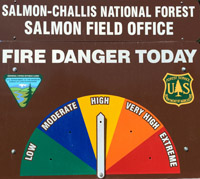 The National Fire Danger Rating System tracks weather events through their effects on live and dead fuels and adjusts them accordingly based on forecasted weather. The most visible product of the system, which is used by most large land management agencies in the United States, is the predicted fire danger, often expressed as adjectives ranging from Low to Extreme.
The National Fire Danger Rating System tracks weather events through their effects on live and dead fuels and adjusts them accordingly based on forecasted weather. The most visible product of the system, which is used by most large land management agencies in the United States, is the predicted fire danger, often expressed as adjectives ranging from Low to Extreme.
The NFDRS was first released for general use in 1972 and was subsequently revised in 1978 and 1988. Work on another revision began in 2000 and is nearing completion. Reportedly this next version is much simpler and more automated than its predecessors and it represents a vast improvement in fire potential assessment capabilities.
Three major changes will be:
- The Fosberg Dead Fuel Moisture Model will be replaced with the Nelson Dead Fuel Moisture Model.
- The Burgan Live Fuel Moisture Model will be replaced with the Growing Season Index-based live fuel moistures.
- The number of fuel models in the NFDRS will be reduced from 40 to 5.
Jon Wallace, a member of the team rolling out and implementing the new system described the transition in an email today:
“The system is expected to be back from contracting and thus complete on November 1st of 2016. After the first of the year we’re going to begin training of Subject Matter Expert groups located within each geographic area, and when that training is complete we will open the system up for all users. We had to wait to conduct this training until the system was fully functional.
“As you can imagine, there is going to be a learning curve for the user community and these Subject Matter Expert groups are going to help us get through that curve within their respective geographic area.
“All members of the user community will be able to see the new NFDRS2016, as well as the 1978 and 1988 NFDRS models during the spring of 2017. This will allow them to work with the subject matter expert groups to set up NFDRS parameters prior to the Summer of 2017 fire season. They will then be able to compare the outputs of the new system to what they are used to seeing in the older versions of NFDRS.
“This side by side comparison will be available to users through the 2018 fire season, at which time we will re-evaluate the need to continue support of the old systems.”

Why not just use the old system? It’s been working for how long? It’s taken 16 years to “revise” it so it seems like they didn’t seem to know what they were revising…
The old system required “human” determined variables (namely, State of Weather) which is somewhat subjective and frequently dubious. The new system uses hourly data (more readily available now than 16 years ago). Human entered variables sometimes took several days to be entered (station owner on vacation, sick, or on a fire). The new system relies solely on actual weather observations, which will eliminate the need to wait for a person to enter variables, and should be up to date as long as the station is transmitting data.
There are other benefits of the redesign, as Bill mentioned above . The science has improved, and the new system incorporates the improvements. Why not use a more timely and scientifically improved system?
Any idea of how simplifying the fuel models from 40 to 5 is beneficial?
Seems like that could be an “oversimplification.”
Also any insight on why Nelson is better than Fosberg?
A growing season index, sounds more nuanced than simply inputting live fuel moisture, is it?
Thanks to anyone with answers.
Good question and point on oversimplification!
John Deeming, the lead developer of NFDRS, proposed 4 fuels models in the 1978 update…and was negotiated upwards by his steering committee. So they used 20, and that doubled to 40 with the ’88 version. More recent analysis has shown a number of these models to be redundant, and there are really 4 or 5 bunches of models that respond very similarly. These will be represented by the fuel models in NFDRS2016. The Nelson method makes use of hourly observations and more sensor data from the RAWS to better reflect changes in fine dead fuel moisture, and also to ‘automate’ State of Weather and Fuels Wet codes. Growing Season Index is a weather-based phenology model that has been shown to relate well to sampled live fuel moisture, and will be calculated every day automatically.
Overall, less moving parts…but better, more effective parts…and less direct reliance on human observations. Less emphasis on day-to-day caretaking of NFDRS observations, leaving room for more emphasis on applying the outputs.